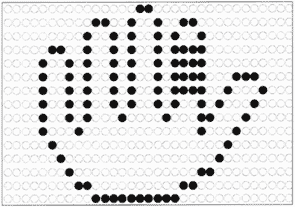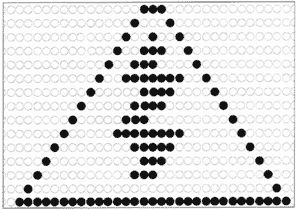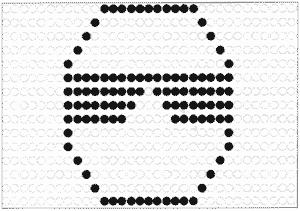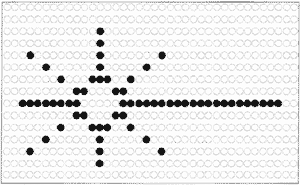ALPHA Message Centers Communicate!
Effective employee communication programs are a direct result of using the right media and getting the most out of the tools that are available. By following these guidelines, you can increase the impact and awareness level of your safety/employee communication programs.
 Notice: Report All Injuries at Once
Notice: Report All Injuries at Once
Part of a Total Communications Program
ALPHA Message Centers are most effective when integrated with a company-wide communications program. For example, they provide dynamic reinforcement to specific safety messages and employee communications printed in your company newsletter.
ALPHA Message Centers can also be used to reinforce your current safety poster program. Consider installing an ALPHA Message Center above or below safety posters for an attention-getting combination.
Finally, when displayed in the company bulletin board/time clock area, ALPHA Message Centers provide an excellent way to promote employee interaction. Use them to call attention to important, time-sensitive information.
 Danger: High Voltage
Danger: High Voltage
Creativity Counts
ALPHA Message Centers are designed with a wide range of display features, so that you can be very creative in selecting how messages will appear/disappear from the screen. By varying the color, character size or type, as well as incorporating eye-catching graphics, you can make each message special. For example, the sparkle-on, spray-on and starburst modes are excellent attention-getters for building an audience. In addition, by injecting a little humor and trivia from time to time, your co-workers will enjoy them even more!
Center of Attention
Finally, don’t forget that one definite way to ensure that your employees will read important company messages is to use an ALPHA Message Center as your primary communications center. By programming messages relating to company events, new employees, policy changes, emergency announcements, sales goals, and more, employees will quickly rely on the ALPHA Message Center as their information source. Plus, they’ll also find it easier to stay on top of what’s happening in the company through easy-to-read messages that they can see from their desk/work area.
The Eyes Have It
Every day, 1,000 American workers injure their eyes in work-related accidents, according to the Occupational Safety and Health Administration. Six hundred of those workers did not wear eye-protection devices. Of those who did, most did not wear a device approved by the American National Standards Institute.
 Danger: Eye Protection Required
Danger: Eye Protection Required
Eye injuries cost more than $133 million a year in lost production, medical expenses and workers' compensation, as well as personal suffering and potential loss of vision. What's most disturbing, says the American Academy of Ophthalmology, is that simple measures can prevent much of the financial and emotional burden caused by eye injuries.
Supervisors need to know the types of protective eyewear devices that are available, and what types the workers they supervise should wear. The U.S. OSHA Act of 1970 says workers must wear protective eye and face equipment whenever it's possible that such equipment could prevent injuries. The employer must provide workers with proper eye protectors, OSHA says, when there are any of the following hazards: flying objects, glare, liquids, or harmful radiation.
Yet a 1988 study of 3,184 patients who visited the emergency ward of a Boston eye hospital found that almost 50 percent of those types of injuries occurred at the workplace. One-third of the people injured at work said that emplo ers did not provide protective eyewear at the work site, says Oliver D. Schein, M.D., principal author of the study.
 Danger: Laser-Wear Eye Protection
Danger: Laser-Wear Eye Protection
Watch for potential eye hazards
Any time you use hand-held, electric or machine tools, says Schein, especially when there's metal on metal, there's a chance of particles flying.
Schein also found that workers who repair and maintain vehicles had a high number of eye injuries. "When you're using tools under pressure, such as pneumatic drills, it's risky for eye safety.
Job-related eye hazards in other industries can include the following: sawdust or fine particles, plaster, spray paint, liquids, and chemicals.
Provide the right protection
Check ANSI Z87.1-1989, Practice for Occupational and Educational Eye and Face Protection. This document sets performance standards for a broad area of hazards. If your work site involves lasers, also see ANSI Z136.1-1986, The Safe Use of Lasers.
The American Academy of Ophthalmologists says eyeglass frames should meet or exceed ANSI requirements. Use safety lenses made from either industrial-grade plastic or polycarbonate.
Workers on some jobs should wear frames with side shields. Others should wear goggles. Those who need protection from ultraviolet or infrared radiation should have special filters.
Contact lens wearers may be at risk
The Contact Lens Association of Ophthalmologists and the National Society to Prevent Blindness have adopted a position paper on industrial workers who wear contact lenses. They suggest that safety and medical personnel determine on an individual basis - whether workers should wear contact lenses on the job. In areas where contacts are allowed, safety personnel should tell workers what type of eye protection they must wear.
Make sure that you, as a supervisor, keep an up-to-date list of all employees who wear contacts. Keep a duplicate list in the plant medical facility. Make sure your first-aid personnel know how to remove contact lenses, both from workers who are conscious or unconscious. Make sure they have quick access to the list of employees who wear contacts. Ask all workers who wear contact lenses to keep a spare pair of contacts and /or prescription glasses at work. That way they can keep working if they damage or lose a contact lens.
(Reprinted with permission from TODAY'S SUPERVISOR, published by the National Safety Council, 1121 Spring Lake Drive, Itasca, IL 60143-3201.)

